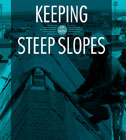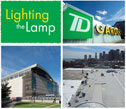Reader concerned about safety
I am a safety director for a large commercial roofing company, and I was quite surprised at the opening photo associated with "Foam up top," January issue, page 26. Several violations clearly are depicted in the photo, and this seems inconsistent with NRCA's dedication to professionalism and safety.
The most glaring safety issue is an uncovered HVAC curb directly behind the workers. Because there is a concrete deck, I presume the deck is open inside the curb. This situation would be considered a serious violation of Occupational Safety and Health Administration (OSHA) regulations.
Additionally, one worker is not wearing a hard hat, and two workers are wearing hard hats improperly. One worker has the bill toward the back, and the other has a baseball cap under his hard hat. The American National Standards Institute (ANSI) only tests and certifies hard hats to be worn with the bill forward, and, therefore, using a hard hat with the bill toward the back would not meet OSHA requirements. Garments detract from a hard hat's protective properties and cause them not to meet ANSI requirements.
Furthermore, the EPS insulation being cut creates many small particles of debris that fly around in the air. Some debris clearly can be seen in the photo. The presence of this loose debris would dictate the use of safety glasses or goggles to protect workers' eyes.
Finally, the worker installing and cutting the EPS insulation is holding a knife without wearing any type of glove to protect his hands against accidental contact with the sharp tool. Such personal protective equipment issues also would indicate a violation of OSHA training requirements.
I suggest Professional Roofing have a safety review of photos used in articles related to roof system installation. NRCA is making great efforts to promote safety and professionalism in the industry. By not publishing photographs that show obvious safety indiscretions, your magazine would do a great service to all of us who dedicate ourselves to occupational safety and health.
Jose Valdez
King of Texas Roofing Co.
Grand Prairie, Texas
Professional Roofing responds: Thank you for your letter. Your concerns are valid, and we appreciate your input. The use of photos, whether to illustrate a roof application procedure or safe work practice or to serve as positive proof of an OSHA violation, can be tenuous at times because snapshots that appear to depict a violation often are inconclusive.
We agree it is always best to use photos that leave no doubt proper work practices are being employed; however, we feel obligated to clarify some of the issues in the photo.
OSHA rules require head protection when there is a danger of head injury from impact
or falling or flying objects. It is not clear from the photo that such hazards exist
to require hard hat use. In addition, the current ANSI/ISEA Z89.1-2009 hard hat
standard allows for the testing of hard hats in the reverse wear position, and a
number of manufacturers market those hard hats marked with this symbol
 . The fact that some workers are wearing
hard hats in reverse configuration is not necessarily a violation.
. The fact that some workers are wearing
hard hats in reverse configuration is not necessarily a violation.
Although OSHA rules do not specifically prohibit the practice, most hard hat manufacturers prohibit anything but approved liners under hard hats to maintain the hard hat's designed protective capacity and failure to follow a manufacturer's instructions in this regard may leave a contractor open to a citation.
It also is impossible to tell from the photo whether interior fall protection is in place on the curb to protect workers on the roof though we agree a cover would otherwise be appropriate. It is important to note other workers who may be on the interior side of any opening also must be protected from objects that may fall through any opening.
Eye and hand protection is required by OSHA when operations could cause injury. Although OSHA often issues a citation for a training violation in addition to the substantive violation in those circumstances requiring personal protective equipment use, more than photographic evidence would be required in almost all instances to support a training violation. Employer records and worker interviews often would be the best evidence of lack of training.
Callback: In the January issue, the headline for Malarkey Roofing Products' story in The Roofing Marketplace, page 56, should have read "New Color Offering for SBS Modified UL Class 4 Shingle." Professional Roofing regrets the error.



